Packaged snacks company Mondelez (NASDAQ:MDLZ) announced better-than-expected results in Q1 CY2024, with revenue up 1.4% year on year to $9.29 billion. It made a non-GAAP profit of $0.95 per share, improving from its profit of $0.86 per share in the same quarter last year.
Mondelez (MDLZ) Q1 CY2024 Highlights:
- Revenue: $9.29 billion vs analyst estimates of $9.16 billion (1.5% beat)
- EPS (non-GAAP): $0.95 vs analyst estimates of $0.89 (7% beat)
- Full year guidance for organic revenue growth and EPS growth maintained from previous outlook
- Gross Margin (GAAP): 51.1%, up from 37.6% in the same quarter last year
- Free Cash Flow of $1.03 billion, down 16.8% from the previous quarter
- Organic Revenue was up 4.2% year on year
- Sales Volumes were down 2.1% year on year
- Market Capitalization: $96.62 billion
Founded as Nabisco in 1903, Mondelez (NASDAQ:MDLZ) is a packaged snacks powerhouse best known for its Oreo, Cadbury, Toblerone, Ritz, and Trident brands.
Although its product portfolio is vast, diverse, and international today, Mondelez traces its roots back to the merger of several small bakeries and cracker manufacturers to form Nabisco (The National Biscuit Company). From there, the company launched the Uneeda Biscuit, which was the first packaged biscuit to be sold nationwide, and in 1921, the Oreo cookie was introduced. In the ensuing decades, Nabisco was owned by a tobacco company, a private equity firm, and Kraft. Present-day Mondelez is the result of a major restructuring of Kraft in 2012.
Today, Modelez produces packaged foods in the snacks, confectionery/candy, and beverages categories. Because of its breadth of brands and products, Mondelez's products cater to a wide variety of consumer preferences and dietary needs–the company sells everything from gluten-free snacks to decadent candies. Almost anyone is a Mondelez potential core customer.
Because of its long-standing, well-known brands, Mondelez's products can be found in a wide variety of stores and retailers worldwide. Global supermarkets, grocery stores, convenience stores, mass merchandisers, and online retailers sell the company’s products, which means consumers are never far from a shelf carrying a Mondelez offering.
Shelf-Stable Food
As America industrialized and moved away from an agricultural economy, people faced more demands on their time. Packaged foods emerged as a solution offering convenience to the evolving American family, whether it be canned goods or snacks. Today, Americans seek brands that are high in quality, reliable, and reasonably priced. Furthermore, there's a growing emphasis on health-conscious and sustainable food options. Packaged food stocks are considered resilient investments. People always need to eat, so these companies can enjoy consistent demand as long as they stay on top of changing consumer preferences. The industry spans from multinational corporations to smaller specialized firms and is subject to food safety and labeling regulations.
Competitors in the packaged snacks and confectionary space include PepsiCo (NASDAQ:PEP), Nestle (SWX:NESN), Hershey (NYSE:HSY), and Kraft Heinz (NASDAQ:KHC).Sales Growth
Mondelez is one of the most widely recognized consumer staples companies in the world. Its influence over consumers gives it extremely high negotiating leverage with distributors, enabling it to pick and choose where it sells its products (a luxury many don't have).
As you can see below, the company's annualized revenue growth rate of 10.1% over the last three years was decent as consumers bought more of its products.
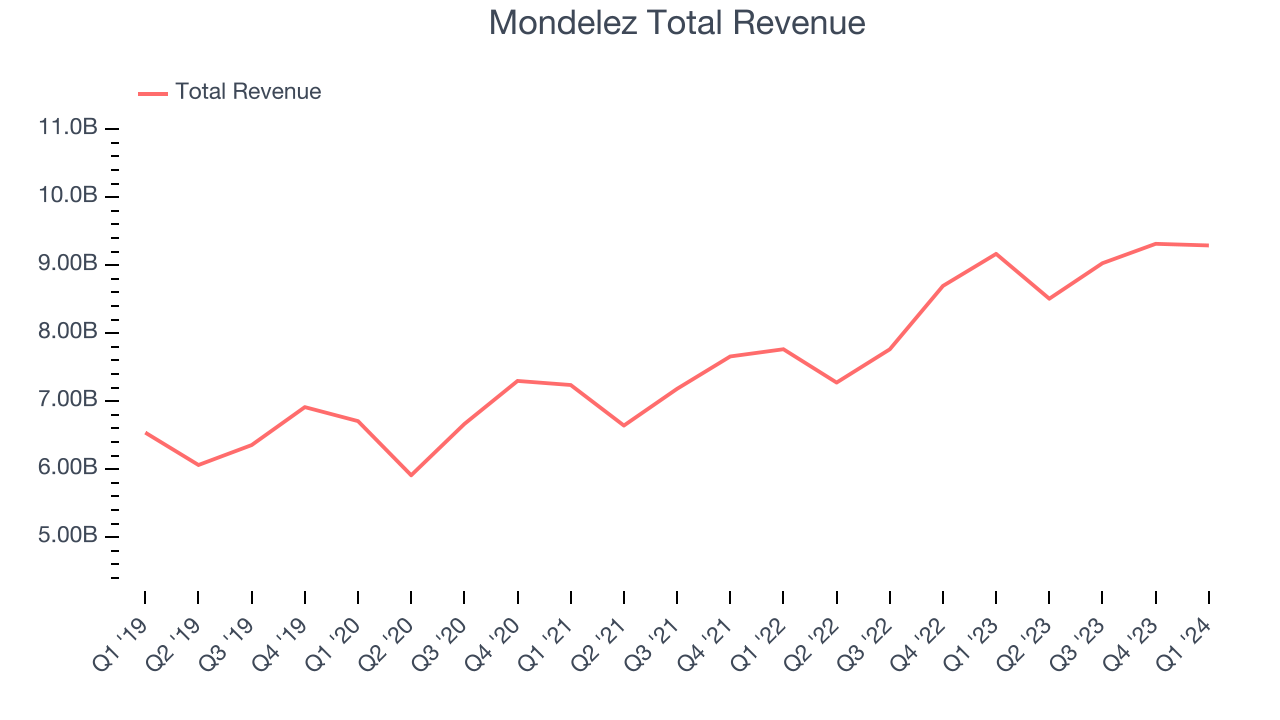
This quarter, Mondelez reported decent year-on-year revenue growth of 1.4%, and its $9.29 billion in revenue topped Wall Street's estimates by 1.5%. Looking ahead, Wall Street expects sales to grow 3.6% over the next 12 months, an acceleration from this quarter.
Volume Growth
Revenue growth can be broken down into changes in price and volume (the number of units sold). While both are important, volume is the lifeblood of a successful staples business as there’s a ceiling to what consumers will pay for everyday goods; they can always trade down to non-branded products if the branded versions are too expensive.
To analyze whether Mondelez generated its growth from changes in price or volume, we can compare its volume growth to its organic revenue growth, which excludes non-fundamental impacts on company financials like mergers and currency fluctuations.
Over the last two years, Mondelez's average quarterly volume growth was a healthy 1.6%. Even with this good performance, we can see that most of the company's gains have come from price increases by looking at its 12.8% average organic revenue growth. The ability to sell more products while raising prices indicates that Mondelez enjoys some degree of inelastic demand.
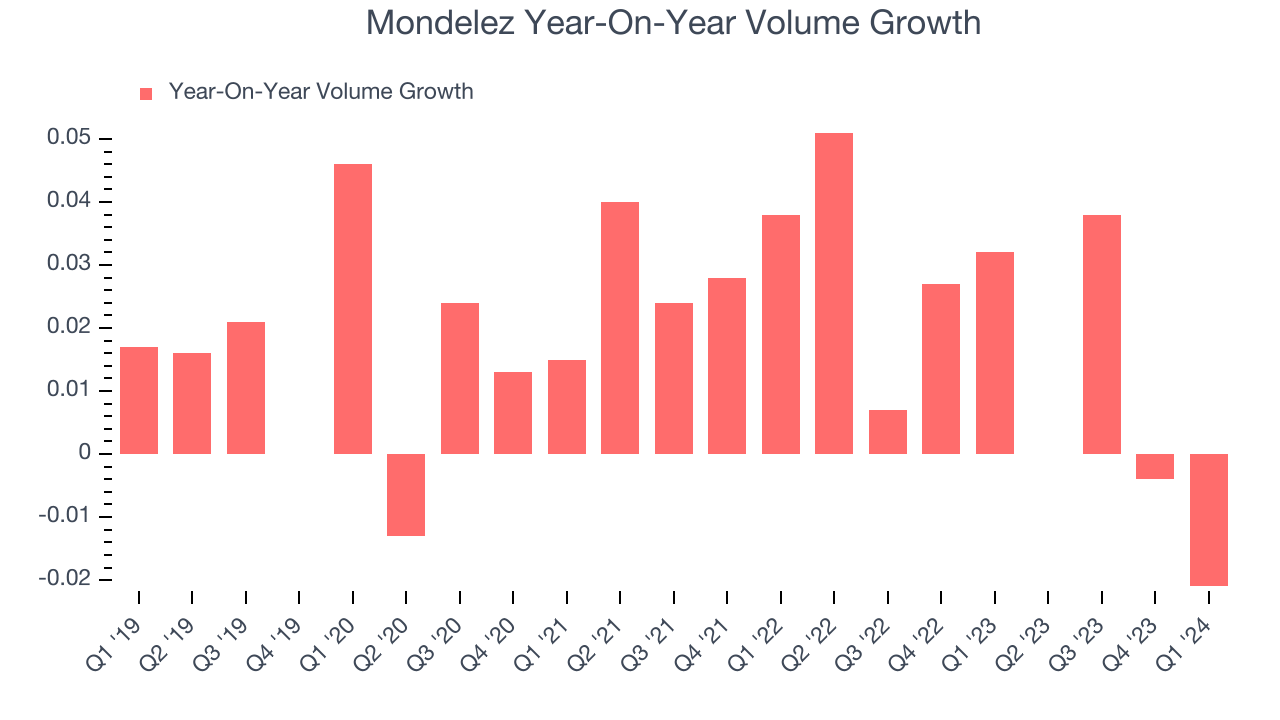
In Mondelez's Q1 2024, sales volumes dropped 2.1% year on year. This result was a reversal from the 3.2% year-on-year increase it posted 12 months ago. A one quarter hiccup shouldn't deter you from investing in a business. We'll be monitoring the company to see how things progress.
Gross Margin & Pricing Power
All else equal, we prefer higher gross margins. They make it easier to generate more operating profits and indicate that a company commands pricing power by offering more differentiated products.
Mondelez's gross profit margin came in at 51.1% this quarter, up 13.5 percentage points year on year. That means for every $1 in revenue, $0.49 went towards paying for raw materials, production of goods, and distribution expenses.
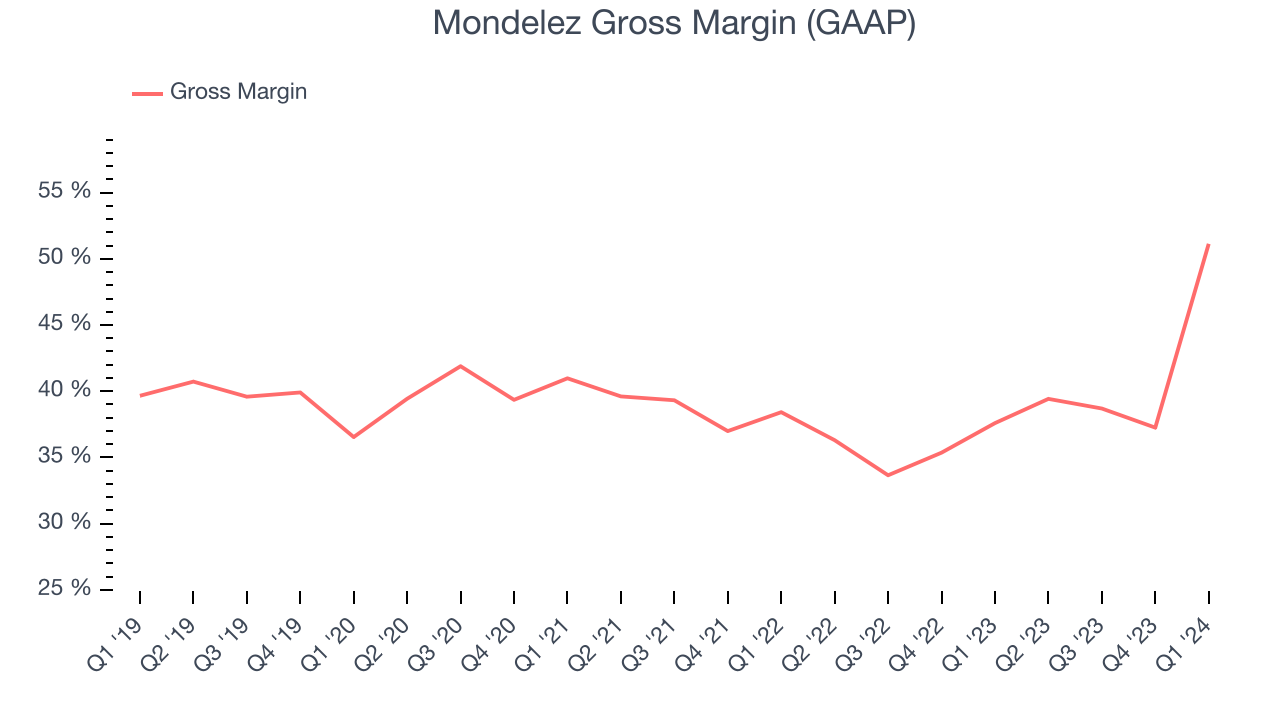
Mondelez has good unit economics for a consumer staples company, giving it the opportunity to invest in areas such as marketing and talent to stay competitive. As you can see above, it's averaged a healthy 38.9% gross margin over the last two years. Its margin has also been trending up over the last 12 months, averaging 16.2% year-on-year increases each quarter. If this trend continues, it could suggest a less competitive environment where the company has better pricing power and more favorable input costs (such as raw materials).
Operating Margin
Operating margin is an important measure of profitability accounting for key expenses such as marketing and advertising, IT systems, wages, and other administrative costs.
In Q1, Mondelez generated an operating profit margin of 29.4%, up 12.9 percentage points year on year. This increase was encouraging, and we can infer Mondelez had stronger pricing power and lower raw materials/transportation costs because its gross margin expanded more than its operating margin.
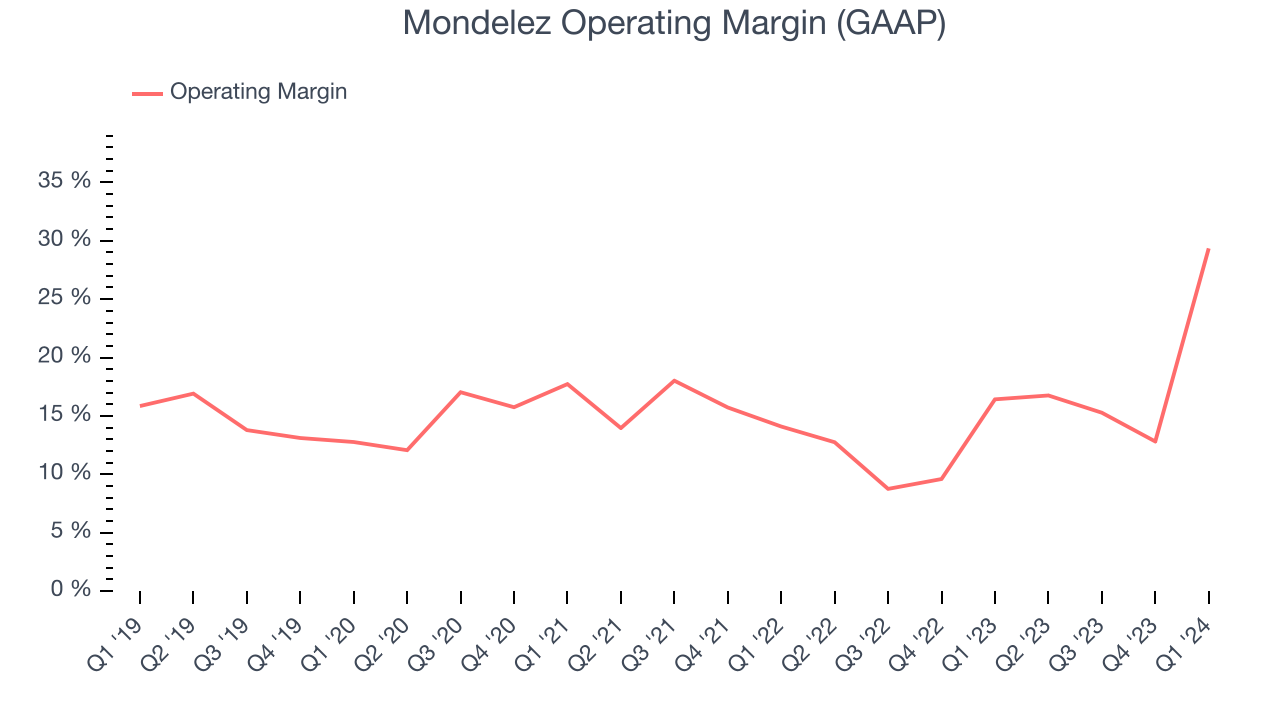 Zooming out, Mondelez has managed its expenses well over the last two years. It's demonstrated solid profitability for a consumer staples business, producing an average operating margin of 15.5%. On top of that, its margin has improved by 6.6 percentage points on average over the last year, a great sign for shareholders.
Zooming out, Mondelez has managed its expenses well over the last two years. It's demonstrated solid profitability for a consumer staples business, producing an average operating margin of 15.5%. On top of that, its margin has improved by 6.6 percentage points on average over the last year, a great sign for shareholders. EPS
These days, some companies issue new shares like there's no tomorrow. That's why we like to track earnings per share (EPS) because it accounts for shareholder dilution and share buybacks.
In Q1, Mondelez reported EPS at $0.95, up from $0.86 in the same quarter a year ago. This print beat Wall Street's estimates by 7%.
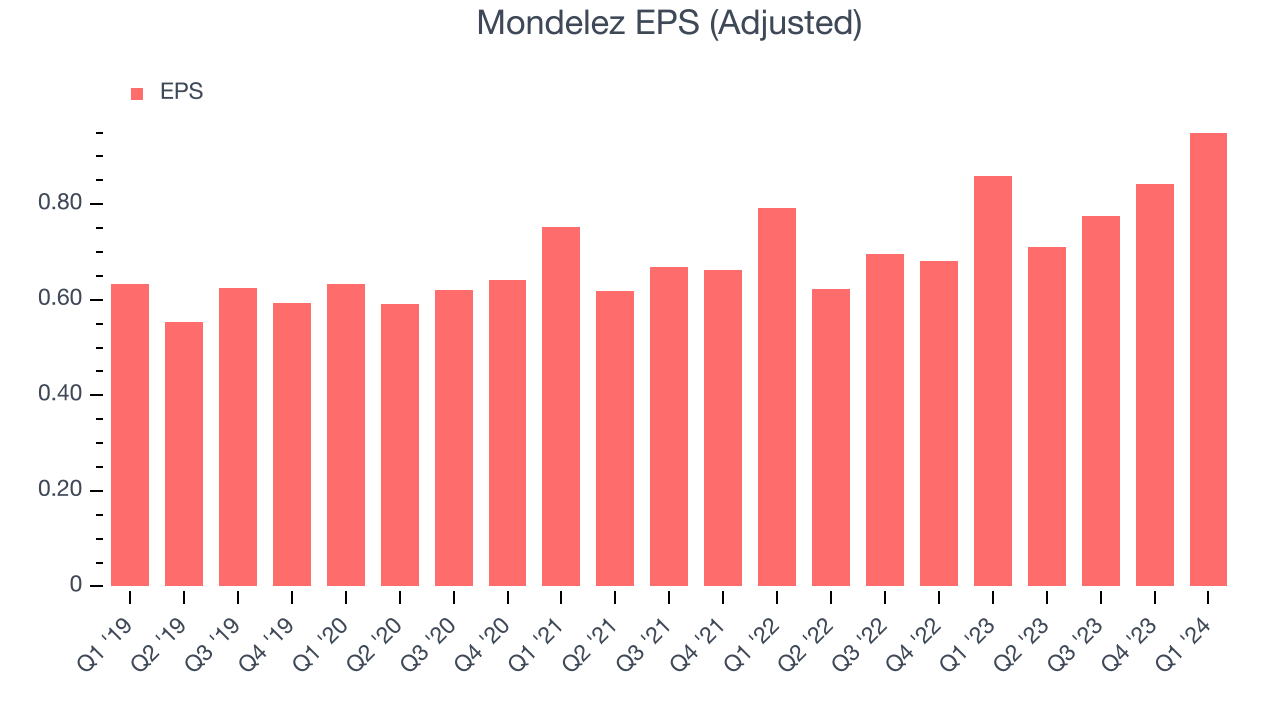
Between FY2021 and FY2024, Mondelez's EPS grew 25.9%, translating into a decent 8% compounded annual growth rate.
Wall Street expects the company to continue growing earnings over the next 12 months, with analysts projecting an average 9.9% year-on-year increase in EPS.
Cash Is King
If you've followed StockStory for a while, you know we emphasize free cash flow. Why, you ask? We believe that in the end, cash is king, and you can't use accounting profits to pay the bills.
Mondelez's free cash flow came in at $1.03 billion in Q1, up 13.9% year on year. This result represents a 11% margin.
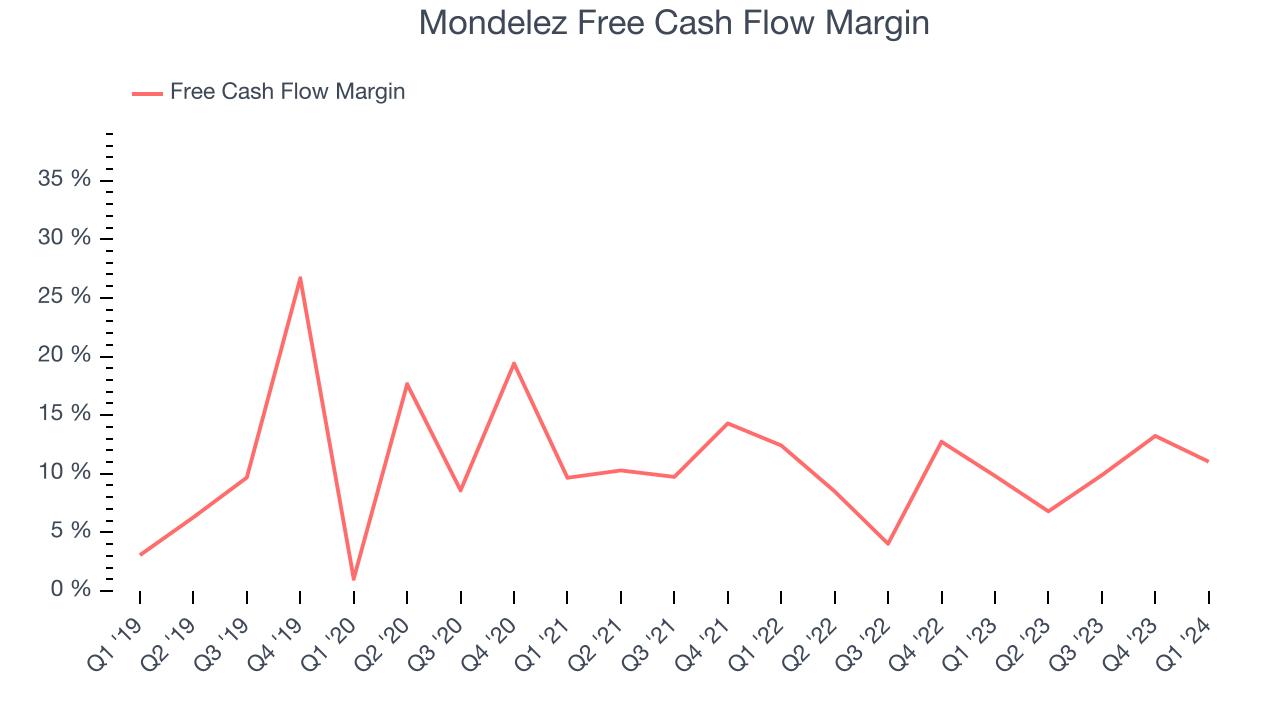
Over the last eight quarters, Mondelez has shown solid cash profitability, giving it the flexibility to reinvest or return capital to investors. The company's free cash flow margin has averaged 9.7%, above the broader consumer staples sector. Furthermore, its margin has averaged year-on-year increases of 1.4 percentage points over the last 12 months. This likely pleases the company's investors.
Return on Invested Capital (ROIC)
EPS and free cash flow tell us whether a company was profitable while growing revenue. But was it capital-efficient? A company’s ROIC explains this by showing how much operating profit a company makes compared to how much money the business raised (debt and equity).
Mondelez's five-year average ROIC was 8.4%, somewhat low compared to the best consumer staples companies that consistently pump out 20%+. Its returns suggest it historically did a subpar job investing in profitable business initiatives.
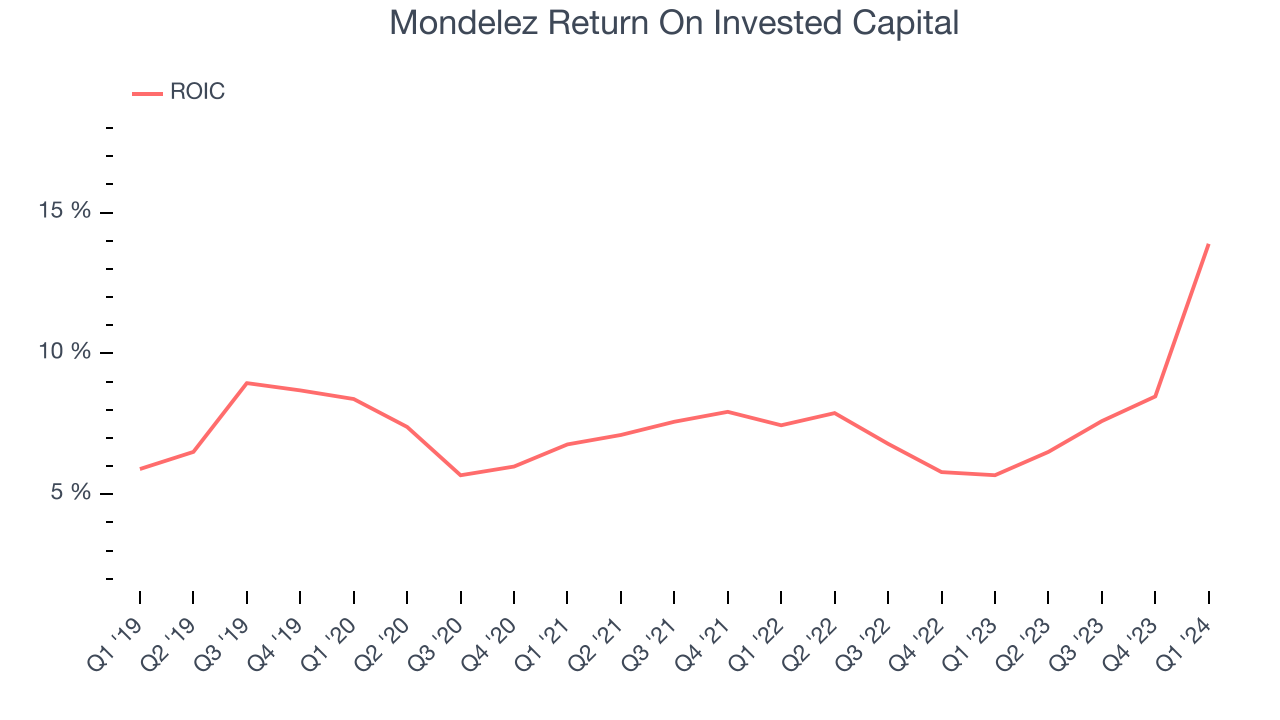
The trend in its ROIC, however, is often what surprises the market and drives the stock price. Over the last few years, Mondelez's ROIC averaged 2.2 percentage point increases. This is a good sign, and if the company's returns keep rising, there's a chance it could evolve into an investable business.
Balance Sheet Risk
As long-term investors, the risk we care most about is the permanent loss of capital. This can happen when a company goes bankrupt or raises money from a disadvantaged position and is separate from short-term stock price volatility, which we are much less bothered by.
Mondelez reported $1.38 billion of cash and $19.06 billion of debt on its balance sheet in the most recent quarter. As investors in high-quality companies, we primarily focus on two things: 1) that a company's debt level isn't too high and 2) that its interest payments are not excessively burdening the business.
With $8.07 billion of EBITDA over the last 12 months, we view Mondelez's 2.2x net-debt-to-EBITDA ratio as safe. We also see its $458 million of annual interest expenses as appropriate. The company's profits give it plenty of breathing room, allowing it to continue investing in new initiatives.
Key Takeaways from Mondelez's Q1 Results
It was good to see that revenue and EPS beat in the quarter. The company maintained its full year guidance for organic revenue growth and EPS growth, showing that the demand environment is unchanged from roughly three months ago when they gave the prior outlook. Zooming out, we think this was a fine quarter with no huge surprises. Investors were likely expecting more, however, and the stock is down 1.8% after reporting, trading at $70.64 per share.
Is Now The Time?
Mondelez may have had a good quarter, but investors should also consider its valuation and business qualities when assessing the investment opportunity.
We have other favorites, but we understand the arguments that Mondelez isn't a bad business. First off, its revenue growth has been solid over the last three years. And while its mediocre ROIC suggests it has grown profits at a slow pace historically, its scale gives it immense negotiating leverage with retailers.
Mondelez's price-to-earnings ratio based on the next 12 months is 20.0x. We don't really see a big opportunity in the stock at the moment, but in the end, beauty is in the eye of the beholder. If you like Mondelez, it seems to be trading at a reasonable price.
Wall Street analysts covering the company had a one-year price target of $81.78 per share right before these results (compared to the current share price of $70.64).
To get the best start with StockStory, check out our most recent stock picks, and then sign up to our earnings alerts by adding companies to your watchlist here. We typically have the quarterly earnings results analyzed within seconds of the data being released, and especially for companies reporting pre-market, this often gives investors the chance to react to the results before the market has fully absorbed the information.
